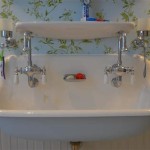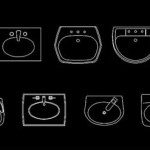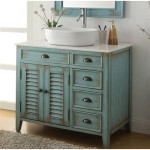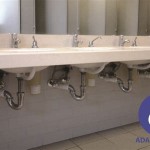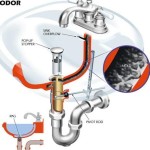How to Cure a Smelly Bathroom Sink Drain
A persistent, unpleasant odor emanating from a bathroom sink drain is a common household woe. This malodor often indicates an accumulation of organic matter and bacterial growth within the drainpipe, trap, or connecting components. Addressing this issue promptly is important not only for maintaining a fresh-smelling bathroom but also for preventing potential drain clogs and more significant plumbing problems.
The root cause of the foul odor often lies in the natural decomposition of materials that find their way down the drain. Hair, soap scum, toothpaste residue, and other bathroom products accumulate over time, clinging to the inner walls of the drainpipe and creating a breeding ground for bacteria. These bacteria break down the organic matter, releasing gases like hydrogen sulfide, which contribute to the characteristic rotten egg smell. The P-trap, a curved section of pipe designed to hold water and prevent sewer gases from entering the bathroom, can also become a trap for debris, exacerbating the problem.
Several methods can be employed to combat this common plumbing issue. The choice of method depends on the severity and persistence of the odor, as well as the homeowner’s preference for natural versus chemical solutions. It's often best to start with the least aggressive method and progress to stronger measures if necessary.
Boiling Water Flush
The simplest, and often the first line of defense, is a generous flush of boiling water. This method is effective at dislodging and dissolving minor accumulations of grease and soap scum. To perform this, bring a kettle or pot of water to a rolling boil. Carefully pour the boiling water directly down the drain, avoiding contact with the sink basin, as extreme temperature changes can potentially damage certain materials. Repeat the process a few times to ensure thorough cleaning. The high temperature of the water helps to melt and carry away the organic buildup that contributes to the odor. Boiling water is generally safe for metal pipes, but caution should be exercised when using it on PVC or plastic pipes, as they may soften or warp under extreme heat. If unsure about the pipe material, it is best to avoid this method or use hot tap water instead, although the results may be less effective.
While boiling water can be effective for minor blockages and buildup, it may not be sufficient for more stubborn or deeply entrenched debris. In such cases, a more aggressive approach is necessary.
Baking Soda and Vinegar Solution
A readily available and environmentally friendly solution involves the use of baking soda and vinegar. This combination creates a chemical reaction that can effectively loosen and dissolve organic matter. Begin by pouring approximately one cup of baking soda down the drain. Follow this with one cup of white vinegar. The mixture will immediately begin to fizz and bubble. Allow the solution to sit for at least 30 minutes, or preferably overnight, to allow the chemical reaction to fully work its magic. The fizzing action helps to dislodge debris and break down the organic matter. After the waiting period, flush the drain with hot water to wash away the loosened material. The baking soda and vinegar solution is generally safe for most types of pipes and plumbing fixtures. For particularly persistent odors, this process can be repeated multiple times. Furthermore, a maintenance dose of baking soda and vinegar once a month can help prevent future buildup and odor development.
The effectiveness of baking soda and vinegar lies in its ability to create a mild acid that breaks down organic matter. While this method is generally effective for mild to moderate odor issues, it may not be strong enough to tackle severe blockages or deeply ingrained debris.
Drain Snake or Plunger
For more stubborn blockages or deeply entrenched debris, mechanical methods such as using a drain snake or plunger may be required. A drain snake, also known as a plumbing snake, is a flexible tool that can be inserted into the drainpipe to physically dislodge or break up obstructions. Insert the snake carefully into the drain opening and feed it down the pipe, rotating it as it goes. When resistance is encountered, attempt to break up or dislodge the obstruction by maneuvering the snake back and forth. Once the obstruction is broken up or removed, carefully retract the snake and clean off any debris. Flush the drain with hot water to ensure that all loosened material is washed away.
A plunger can also be an effective tool for dislodging blockages. Ensure that there is enough water in the sink basin to cover the cup of the plunger. Create a tight seal around the drain opening with the plunger cup and vigorously plunge up and down for several minutes. Remove the plunger to see if the water drains freely. Repeat the process if necessary. The plunging action creates pressure that can dislodge obstructions in the drainpipe.
When using a drain snake or plunger, it is crucial to exercise caution to avoid damaging the pipes. Applying excessive force can potentially crack or break the drainpipes, leading to costly repairs. It is also advisable to wear gloves to protect hands from contact with potentially contaminated water and debris.
Cleaning the P-Trap
If the above methods prove ineffective, the P-trap, the curved section of pipe under the sink, may be the source of the odor. The P-trap is designed to hold water, which prevents sewer gases from entering the bathroom. However, it can also accumulate debris and organic matter, leading to odor issues. To clean the P-trap, place a bucket or container under the trap to catch any water that may spill out. Loosen the slip nuts that connect the P-trap to the drainpipes. Carefully remove the P-trap and empty its contents into the bucket. Rinse the P-trap thoroughly with water to remove any remaining debris. Inspect the inside of the P-trap for any signs of buildup or corrosion. If necessary, scrub the inside of the P-trap with a brush and soapy water. Reassemble the P-trap, ensuring that the slip nuts are tightened securely but not overtightened. Run water through the drain to check for leaks.
Cleaning the P-trap can be a messy process, so it is important to take precautions to protect the surrounding area. Wearing gloves and eye protection is also recommended. If the P-trap is severely corroded or damaged, it may need to be replaced.
Commercial Drain Cleaners
Commercial drain cleaners are available in various formulations, including liquid, gel, and granular forms. These products contain chemical agents that dissolve or break down organic matter and clear drain blockages. While commercial drain cleaners can be effective, they should be used with caution due to their potentially harmful effects. These products often contain harsh chemicals that can damage pipes, especially PVC or plastic pipes. They can also pose a health hazard if not handled properly. Always follow the manufacturer's instructions carefully when using commercial drain cleaners. Wear gloves and eye protection to protect skin and eyes from contact with the chemicals. Avoid mixing different types of drain cleaners, as this can create dangerous fumes. Ensure adequate ventilation in the bathroom when using these products.
Due to the potential risks associated with commercial drain cleaners, it is generally recommended to try other methods first, such as boiling water, baking soda and vinegar, or mechanical methods. Commercial drain cleaners should be reserved for situations where other methods have failed and the blockage is severe.
Preventative Measures
Preventing the accumulation of debris and organic matter is the best way to avoid smelly bathroom sink drains. Several simple preventative measures can be taken to minimize the risk of odor issues. Avoid pouring grease or oil down the drain, as these substances can solidify and create blockages. Use a drain strainer to catch hair and other debris before they enter the drainpipe. Regularly flush the drain with hot water to help prevent buildup. Periodically pour a baking soda and vinegar solution down the drain as a maintenance dose. By implementing these preventative measures, individuals can significantly reduce the likelihood of experiencing smelly bathroom sink drains and maintain a fresh and clean bathroom environment. Regularly cleaning the stopper of the drain can also help prevent build up on the drain and stopper itself, preventing foul odors.

How To Clean A Stinky Sink Drain By Home Repair Tutor
:max_bytes(150000):strip_icc()/__opt__aboutcom__coeus__resources__content_migration__mnn__images__2018__08__sink_drain-351af8e441034f319fe07f00c091d8b6.jpg?strip=all)
How To Clean A Smelly Drain Naturally

How Can I Help A Stinky Bathroom Sink Drain Cleaning More

How To Clean A Smelly Sink

How To Clean Smelly Drains Living By Homeserve

How To Clean Stinky Drains Liquid Plumr

Why Your Drain Smells And How To Fix It Fast

How To Clean A Smelly Drain Rainbow Restoration

Prevent Drain Smells Deodorize Your Drains

What Causes Bathroom Drains To Smell
Related Posts

